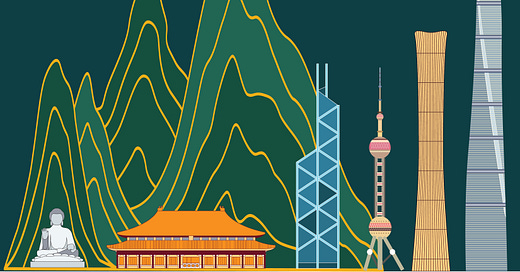Welcome to Sinocities
Disaggregating China, from mega city regions to new areas, county towns to villages!
Today, I’m announcing the rebranding of “A Space Between” into Sinocities, a substack focused on cities in China. After all, over 800 million people live in Chinese cities. From urban development and policy to urban technology, architecture, urban history, and everything in between, Sinocities will continue to be a “space between” these varied but related ways of looking at the city and more broadly “space” in China. Coming from an academic perspective in urban studies and planning but attuned to broader conversations, Sinocities is aimed at specialist and generalist readers alike!
In many respects, the story of China’s rapid economic boom is the story of urbanization. Some might think that with the era of slowing growth and sinking real estate market, China’s urbanization story is over. But 35% of the country (477 million people by some measures) remain rural, and there are continued policy efforts to further urbanize the country to reach to reach a percentage of “developed countries” around 80% which is forecasted for 2035.1 No matter how these numbers shape up in the next couple decades (not to mention debates about what these numbers obscure), the role of place and space ( both urban, rural, and areas in between) remains central to understanding China. This includes issues such as local development, land finance, new urban districts and new economic zones (I promise I will write on other places than Xiongan soon), infrastructure, migration, hukou reform, ecological protection (and oh don’t forget, ‘ecological civilization’). All of these domestic topics remain at the center of the broader “China story” during the 新时代 or “new era” and have important implications for other aspects of China’s development such as technology policy, economic growth, domestic stability, and international relations.
Furthermore, China is such a vast country that any attempt to grapple with its complexity needs to understand regional and local particularities. There’s a lot of good China content in the English speaking world, both from international scholars but also increasingly China-based scholars writing in English. But there’s still very little that focuses on specific locales and specific places as a lens into the complexity and variety of China’s development.
Finally, Sinocities will have a China focus but this will not preclude stories and attention on related places if there is a China angle—for example Belt and Road projects abroad, or the impact of Chinese migration and investment in other cities globally. The “Sino” connotes not just “China” but also the broader Sinosphere—East Asia, and increasingly Southeast Asia and beyond. Of course, this substack should not be confused with the excellent and broader “Sino-themed” substacks out there such as Sinocism and Sinica.
Finally, a word on the logo of Sinocities: the color scheme of green-blue is inspired by a genre of traditional landscape painting known as Qinglü 青綠 that was often used to suggest mythical or historical landscapes2. It features a series of repeating mountain forms and iconic buildings of China ranging from Taihe Dian (the Hall of Supreme Harmony in the Forbidden City) to Shanghai Tower, the tallest building in China—see if you can name the rest. The image was also inspired by lines of a Chinese poem 山外青山楼外楼 (“mountains beyond mountains, buildings beyond buildings) that described the infinite space and wealth of the city of Hangzhou (Lin’an in the southern Song dynasty).
For now, this substack will remain free. But look out for future special content or special reports that may eventually go behind a paywall to support this work. Thanks very much for reading and please feel free to get in touch!
Best,
Andrew
https://www.prcleader.org/post/china-s-aging-problem-will-be-much-more-serious-when-urbanization-is-completed
https://artmuseum.princeton.edu/object-package/blue-green-realms-chinese-painting/170144






Wow! Looking forward to reading your articles! Great logo!
Congratulations on graduating and I'm looking forward to what comes next!